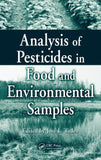Sensory-Directed Flavor Analysis by Ray Marsili
SENSORY-DIRECTED FLAVOR ANALYSIS
By Ray Marsili
SPECIAL INDIAN REPRINT
Reference - 288 Pages - 102 B/W Illustrations
Features
Using a systematic approach to determine which techniques to use under which circumstances for studying a specific flavor problem, this book-
Summary
Today, flavor chemists can generate copious amounts of data in a short time with relatively little effort using automated solid phase micro-extraction, Gerstel-Twister® and other extraction techniques in combination with gas chromatographic (GC) analysis. However, more data does not necessarily mean better understanding. In fact, the ability to extract, isolate, and concentrate potential flavor-important chemicals from complex food systems has surpassed the ability to understand how the chemical data relates to flavor.
Sensory-Directed Flavor Analysis helps chemists unlock the flavor secrets that may be hiding in their chromatograms by translating cold hard numbers into a better understanding of the sense of smell and taste. The author integrates the two disciplines of sensory science and analytical chemistry, encouraging sensory scientists to incorporate more analytical data while encouraging analytical chemists to include more sensory techniques. Using more ancillary techniques helps each discipline elucidate how various chemical constituents influence food flavor and appeal. The book discusses important enabling technologies and analytical methods including GC-olfactometry (GC-O), combination GC-O and multi-dimensional GC, the application of odor activity values (OAVs), and recombination studies, as well as solid-phase dynamic extraction and preseparation techniques. A broad array of applications, in addition to dozens of tables, graphs, gas chromatograms, and pictures, are included throughout the book.
Highlighting the advantages and disadvantages and the appropriate circumstances for each method of analysis, Sensory-Directed Flavor Analysis offers flavor scientists an essential reference to deepen their understanding of the function of chemicals on the perception of taste.
Table of Contents
Comparing sensory and analytical chemistry flavor analysis, R. T. Marsili
Relating sensory and instrumental analyses, M.A. Drake, R.E. Miracle, A.D. Caudle, and K.R. Cadwallader
Application of sensory-directed flavor-analysis techniques, R. T. Marsili
An integrated MDGC-MS-olfactometry approach to aroma and flavor analysis, D. K. Eaton, L. T. Nielsen, and D. W. Wright
Preseparation techniques in aroma analysis, M. C. Qian, H. M. Burbank, and Y. Wang
Solid phase dynamic extraction: A technique for extracting more analytes from samples, I. Christ, U. B. Kuehn, and K. Strassburger
The application of chemometrics for studying flavor and off-flavor problems in foods and beverages, R. T. Marsili
Sensometrics: the application of multivariate analysis to sensory data, S. Karow, Y. Fu, and T. Laban
Character-impact flavor compounds, R. J. McGorrin
Index


















